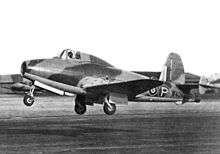1941 in science
| |||
|---|---|---|---|
The year 1941 in science and technology involved some significant events, listed below.
Biology
- George Wells Beadle and Edward Lawrie Tatum publish "Genetic Control of Biochemical Reactions in Neurospora" which shows that specific genes code for specific proteins.[1]
- John William Field develops Field stain to detect malarial parasites.[2]
Chemistry
- February 23 – Chemical element 94, plutonium, is first synthesized by Glenn T. Seaborg, Arthur C. Wahl, Joseph W. Kennedy and Emilio Segrè. It is kept secret until after the atomic bombings of Hiroshima and Nagasaki, as it is being developed for the first atomic bombs.
Computer science
- May 12 – German engineer Konrad Zuse presents the Z3, the world's first working programmable, Turing complete, fully automatic computer, to an audience of aviation engineers in Berlin.
- John Vincent Atanasoff and Clifford E. Berry develop the Atanasoff–Berry Computer.
History of science
- Charles Singer's A Short History of Science to the Nineteenth Century published in the U.K.
Mathematics
- Cahit Arf defines the Arf invariant of a nonsingular quadratic form over a field of characteristic 2.
Medicine
- February 12 – Reserve Constable Albert Alexander, a patient at the Radcliffe Infirmary in Oxford, becomes the first person treated with penicillin intravenously, by Howard Florey’s team. He reacts positively but there is insufficient supply of the drug to reverse his terminal infection. A successful treatment is achieved during May.[3]
- April – Birmingham Accident Hospital opens as the world's first trauma centre in Birmingham, England.[4]
- The Pharmacological Basis of Therapeutics is first published in New York by Alfred Gilman and Louis S. Goodman, pharmacologists at the Yale School of Medicine.[5]
Mineralogy
- German mineralogist Karl Hugo Strunz's Mineralogische Tabellen introduces Nickel–Strunz classification of minerals.[6]
Physics
- June – British scientist G. I. Taylor predicts the blast effects from an atomic bomb.[7]
- June 28 – President of the United States Franklin D. Roosevelt signs Executive Order 8807 creating the Office of Scientific Research and Development with Vannevar Bush as its director. The office is charged with production of an atomic bomb.[8]

The Gloster E.28/39, the first British aircraft to fly with a turbojet engine
Technology
- May 15 – First flight of the Gloster E.28/39, the first British jet aircraft.
- November – Prototype AI Mk. VIII radar, the first operational microwave-frequency Airborne Interception radar, introduced by the British Royal Air Force.
Events
- February 20 – Polish microbiologist Ludwik Hirszfeld, his wife, Hanka, and daughter are forced to move into the Warsaw ghetto; here for two years he organizes anti-epidemic measures and vaccination campaigns against typhus and typhoid, as well as conducting secret medical courses.
Awards
- July 4 – Frederick Lindemann is raised to the British peerage as Baron Cherwell.[9]
Births
- January 16 – András Sárközy, Hungarian mathematician.
- March 26 – Richard Dawkins, British evolutionary biologist.
- March 27 – Simon Campbell, British chemist.
- May 25 – Uta Frith, German-born British developmental psychologist.
- June 20 – Robert D. Acland (died 2016), English-born microsurgeon.
- August 2 – Jules A. Hoffmann, Luxembourg-born winner of the Nobel Prize in Physiology or Medicine (2011).
- August 22 – Peter Murray-Rust, British chemist and Herman Skolnik Award winner.
- September 9 – Dennis Ritchie (died 2011), American computer scientist.
- September 10 – Stephen Jay Gould (died 2002), American paleontologist/evolutionist.
- Vivian Pinn, American physician.
- Dan Shechtman, Israeli winner of the Nobel Prize in Chemistry (2011).
- Ray Tomlinson (died 2016), American computer scientist.
Deaths
- February 21 – Sir Frederick Banting (born 1891), Canadian discoverer of insulin, winner of the Nobel Prize in Physiology or Medicine (1923) (military aircraft accident)
- June 6 – Louis Chevrolet (born 1878), Swiss-born race driver and automobile builder in the United States.
- July 11 – Sir Arthur Evans (born 1851), English archaeologist.
- July 26 – Henri Lebesgue (born 1875), French mathematician.
- November 18 – Walther Nernst (born 1864), German physical chemist.
References
- ↑ Beadle, G. W.; Tatum, E. L. "Genetic Control of Biochemical Reactions in Neurospora" (PDF). Proceedings of the National Academy of Sciences. United States. 27: 499–506. doi:10.1073/pnas.27.11.499. PMC 1078370
 . PMID 16588492. Retrieved 2011-06-07.
. PMID 16588492. Retrieved 2011-06-07. - ↑ "Obituaries" (PDF). Medical Journal of Malaysia. June 1981. Retrieved 4 May 2015.
- ↑ Robertson, Patrick (1974). The Shell Book of Firsts. London: Ebury Press. pp. 124–5.
- ↑ "1941 First Trauma Centre Birmingham Accident Hospital and Rehabilitation Centre, Birmingham, UK". Trauma Systems. Trauma.org. Retrieved 2016-03-26.
- ↑ Ritchie, Murdoch (1996). A Biographical Memoir of Albert Gilman (PDF). National Academies Press. pp. 60–63. Retrieved 2015-03-26.
- ↑ Knobloch, Eberhard (2003). The shoulders on which we stand/Wegbereiter der Wissenschaft (in German and English). Springer. pp. 170–173. ISBN 3-540-20557-8.
- ↑ Taylor, Geoffrey (1950). "The formation of a blast wave by a very intense explosion". Proceedings of the Royal Society. London. A201: 159 ff. JSTOR 98395. The report was classified when written.
- ↑ Hewlett, Richard G.; Anderson, Oscar E. (1962). The New World, 1939–1946. University Park, Pennsylvania: Pennsylvania State University Press. pp. 40–41. ISBN 0-520-07186-7. OCLC 637004643.
- ↑ The London Gazette: no. 35217. p. 3991. 11 July 1941.
This article is issued from Wikipedia - version of the 3/27/2016. The text is available under the Creative Commons Attribution/Share Alike but additional terms may apply for the media files.